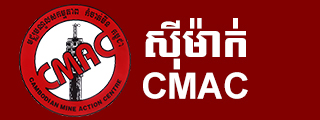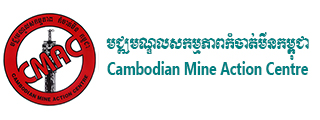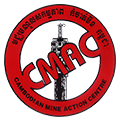Integrated Mine Clearance and Development
CMAC has long been a proponent of integrating sustainable development activities into its demining operations. Partnering with international NGOs and other international organizations, and private companies, CMAC has established a holistic approach to community and victim support by implementing projects with a strong community development focus after its demining activities. Some projects have its development packages to sustain rehabilitation in the local area, if not CMAC will approach other NGO’s and private companies or individual to provide development assistance.
Development-orientated mine action does not simply clear landmine/UXO but also promotes the development of local communities by enabling them to use the land after clearance has taken place. Furthermore, local empowerment is enhanced by including members of affected communities in the mine action planning process.
1. Development Activities and Projects Facilitated by CBMRR staff
Mine and UXO committees (Volunteer networks) of the Community-Based Mine Risk Reduction Program (CBMRR) have built strong relationships with development partners to bring development projects into their communities. These development projects include rehabilitation and construction of rural roads to a total length of 94,404 meters (laterite, earth roads and new track roads); 11,910 meters of farm canal; 6 schools; 15 water wells-hand pumped; 6 community ponds; water supply within 185 villages, which have benefited up to 17,973 families.
2. Good Earth Japan (GEJ)
CMAC has collaborated with Good Earth Japan (GEJ), a Japanese non-profit organization since 2007 to promote post-mine clearance development of the affected communities, in order to improve the living standard of the people and support the socio-economic development of Cambodia. In the first semester 2011, CMAC, in partnership with GEJ, and in collaboration with the Provincial Department of Rural Development (PDRD) and Provincial Department of Agriculture (PDA) of Battambang implemented a post-mine clearance development project in Ratanak Mondul, Banan and Bavel districts of the Battambang province. The main achievements of this project are as follows:
2.1. Road Construction
- 4,265 meters of laterite road, 5 meter top wide, was rehabilitated by CMAC’s civil engineering team lined from O’Slabang to Prey Preal village to link transportation and economic activities of the three districts namely Banan, Ratanak Mondul and Bavel of the Battambang province. 9 pipe culverts including 2 single pipe culverts and 7 double pipe culverts were constructed along this road.
- 1,686 metres of laterite road, 5 meter top wide, was rehabilitated by CMAC’s civil engineering team in O’Slabang village, Takream commune, Banan district of the Battambang province.
2.2. Construction of Community Ponds
Nine (9) community ponds were constructed by CMAC’s civil engineering team in Kork Chor, Raksmey Sangha and Andoeuk 11 villages of the Sdao commune, Ratanak Mondul district. The size the community ponds varies from 30x40x4m to 40x40x4m based on the requirement of the community and the availability of land for pond construction. These 9 ponds benefit 1,885 families of the 3 villages mentioned above.
2.3. Agriculture Training
The Good Earth Japan in partnership with CMAC has entrusted Battambang Provincial Department of Agriculture to implement agriculture training in the post mine clearance areas in Ratanak Mondul and Bavel districts of the Battambang province. The agriculture training focused on rice cultivation, corn, mushroom, vegetable and chicken raising aiming to improve the living standard of the mines and UXO affected communities through income generation.
During this reporting period, 990 farmers received agriculture training, in which 300 farmers were trained in rice cultivation (System Rice Intensification), 180 farmers trained on corn production, 180 trained on mushroom growing, 180 trained on vegetable production and 150 trained on chicken raising.
Among the total trainees, 150 farmers were from Kork Chor village, 390 farmers from Raksmey Sangha village, 300 from Andouek 11 village, 60 farmers from Prey Preal village, 60 farmers from Tumnup Takuon village and 30 farmers from Tuol Snoul. The farmers from Prey Preal, Tunub Ta Kuon and Tuol Snoul villages, Kdol Tahen commune, Bavel district of the Battambang province received their first course in rice cultivation (SRI), while Kork Chor, Raksmey Sangha and Andoeuk 11 of the Sdao commune, Ratanak Mondul district, Battambang province received all courses mentioned above.
3. Mine Clearance in Battambang (MCB) Project
The Mine Clearance in Battambang (MCB) project combines two component projects: Community Based Demining (CBD) and Safety Village Construction (SVC), which not only focuses on demining but also on community development. It aims to bring about the personal security and safety of the people and community living in mine affected areas in Kilo & Chea Montrey village, Treng commune, Ratanak Mondul district, Battambang province, and to improve their economic and social opportunity through community infrastructure rehabilitation and development. This project covers a period of April 2010 to July 2011.
The project was implemented by CMAC in partnership with Japan Mine Action Service (JMAS) in Kilo and Chea Montrei villages, Traeng commune. The project had two separate components which carried out different tasks including (1) Demining component, consisting of one demining machine, one brush cutter machine, and one mobile platoon assigned to provide demining services to support the infrastructure construction activities, and (2) Infrastructure construction component assigned to carry out community development activities. The project was jointly funded by KOMATSU Co. Ltd and Japanese Government Fund through JMAS.
In the first semester 2011, the MCB Project produced the following outputs.
- 3,500 meters of laterite road with both-side waterway, 3 pipe culverts and one spillway constructed.
- 8 community ponds constructed.
- 1 school building with 3 classrooms and 1 staff room constructed.
- 3 wells constructed.
According to plan, the safe land and infrastructure developed after mine clearance would be handed over to local authorities for further distribution to around 500 poor and landless families, who would be resettled into the Kilo and Chea Montrei Villages. The official hand-over ceremony was organized in the project site on March 7, 2011 and presided over by H.E Prak Sokhonn, Minister attached to the Prime Minister and Vice-President of the Cambodian Mine Action and Victim Authority (CMAA).
The actual land distribution after clearance was made on June 15, 2011 through lucky draw at the project site in Kilo Village, Traeng Commune, witnessed by H.E Im Chhun Lim, Senior Minister, Minister of the Ministry of Land Management, Urban Planning & Construction, H.E Heng Ratana, CMAC Director General and Battambang Governor HE Prach Chan as well as other relevant local authorities and development partners. The cleared land was distributed to 491 beneficiary families.
In addition, 2,000 meters of laterite road was constructed in Ou Anlork village, Tasen commune, Kamrieng district of the Battambang province under the CBD component of the MCB project with charity from the People of Japan and counterpart fund from the Commune Council of Tasen Commune.
4. Program for Integrated Mine Clearance and Landmine Victim Assistance “The Peace-building Project”
While the presence of landmine/UXO is a direct security threat to communities living in and around minefields, it is also a significant obstacle to the social and economic development of those communities. Many minefields in remote areas considerably affect the poorest farmers. Accordingly, in December 2008, CMAC requested the Government of Japan, through the Royal Government of Cambodia, to implement a conflict prevention and peace building program to accelerate mine clearance activities by applying integrated mine clearance technologies, developed through research and development activities for mine clearance related equipment in Cambodia. The request also included a component of local development in mine affected communities with a particular focus on agriculture and infrastructure development.
The overall objective of this program is to sustainably improve the livelihood and food security of the poorest farmers who live in the landmine contaminated area of Ou Donpov and Kampong Makak village, Kdol Tahaen commune, Bavel district, and Rossei Ro village, Takream commune, Banan district. This is achieved through community assistance which promotes the productive use of land after mine clearance activities and provides communities with necessary agricultural support.
4.1. Project Objective
- To strengthen landmine and explosive remnant of war (ERW) clearance activities of CMAC through the procurement of necessary equipment
- To clear large areas of contaminated land and provide communities with a safer environment by integrating the operation of mechanical and manual demining through support of operations expenses to CMAC
- To improve the livelihoods of people living in selected mine-affected villages through appropriate assistance for sustainable development
4.2. Project Achievements
The project started its demining operation in two selected sites: Site I covers Kampong Makak and Ou Donpov villages and Site II covers Russeiro community, Slabang village. The demining in site I was completed in June 2011 and the project to moved to site III in the same month.
As of June 2011, the Project employed a total of 204 staff, which included a project management team, a community assistance team, 8 demining machines teams, 4 mobile platoons, 4 mine detection dog teams, a brush cutter team, 2 explosive ordnance disposal teams, a civil engineering team, an agricultural land preparation team and 2 community-based mine risk reduction (CBMRR) staff.
Mine Clearance Achievements
During January-June 2011, the project cleared 5,812,722 m2 (581.3 ha) of contaminated area in the target villages, found and destroyed 655 landmines and UXO including 317 anti-personnel mines, 16 anti-tank mines, 318 unexploded ordnances and 4 improvised mines. The achievements of the project classified by location can be summarized in the table below.
The progress productivity, classified by demining teams, of the mine clearance component is summarized in the table below.
Two district focal points (DPF) of the Community-Based Mine Risk Reduction Program (CBMRR) were deployed to coordinate and facilitate mine action activities, mine risk education, victim assistance and development activities in target districts. As a result, 177 mine risk education courses were conducted and reached 3,269 people, of whom 1,286 were men, 1,098 women and 885 children. CBMRR staff also conducted consultation for behavior changes for 51 households in the target district.
In addition, 2 explosive Ordnance Disposal team (EOD) were deployed to respond to the requests from the landmine and UXO affected communities, to collect and destroy mine and UXO, and conduct limited clearance for risk reduction purposes. For instance, 268 requests from the communities were responded by the teams, which then collected and destroyed 4,786 mines and UXO, including 1,089 anti-personnel mines, 40 anti-tank mines and 3,657 UXO.
All teams were expected to clear approximately 72 hectares per month or 432 hectares for the reporting period. The teams actually cleared 581.3 ha or equal to 134% compared to the operational plan. The demining achievements of the project by semester are presented in the graph below.
The demining operation in Site I was completed in June 2011. To continue with the demining operations, Site III was identified, assessed and selected in collaboration with JICS staff. The criteria for selection of the site III also followed the same mechanism of PMAC/MAPU process as well as ensuring the site is suitable for the deployment of demining machines and other tools in both dry and wet seasons. The site selection also took into account the distance to the old site to minimize transportation cost.
Based on the criteria mentioned above, three villages including Buo Sangkreach, Chrang Bak and Trapeang Kbal Sva were selected for Site III of the project. Based on the updated baseline survey data provided from CMAA, the three villages contain a total of 33,031,506 m2 of contaminated land (199 minefields). 15 minefields (163 ha) and 7 spare minefields (110 ha) of the 199 minefields were selected for demining operations of the project in 2011.
The accommodation at site I is used to support the demining operation activities in Site III. Sub-sites in the target villages of the Site III were also prepared for specific teams, to enable them to conduct their tasks in an effective and efficient manner.
Community Assistance
The community assistance concept and operation was designed on the basis of the actual needs of target villages, such as land reclamation, agricultural infrastructure construction and agriculture training, with the aim to convert the minefields into farmland after the demining operation. Key stakeholders such as provincial governor, relevant provincial departments (water resource, environment, provincial rural development, provincial department of agriculture, and the forestry administration) as well as local authorities (district & commune chief) are strong advocates and participants of the whole process. Three main activities were carried out.
Farming Support/ Land Reclamation
Land preparation activity took place from March to June 2011 with a plan to achieve 504 hectares of agricultural land. The project actually achieved 501.9 hectares of land preparation, which means that the prepared land can be used for farming in an efficient manner. 239.2 hectares of the total land benefited 69 families in Kampong Makak village and 262.7 hectares benefited 58 families in Ou Donpov village. The land preparation work was undertaken by two Tractor teams under the management and supervision from the Community Development team of the Peace-building project.
Infrastructure Construction
The infrastructure construction was based on the results of technical survey and design by the Battambang Provincial Technical Departments (Provincial Development of Rural Development-PDRD). Progress of road construction is indicated in the table below:
The project planned to construct a total 17,762 liner meters (three years or just this year?) of road after landmine clearance. During the reporting period, 10,110 of 17,762 liner meters was 100% completed, and the other 7,652 liner meters were 70% completed.
The construction of cross structure was also conducted based on the drawing designed by the PDRD. The progress the construction of cross structure is indicated in the table below:
Agriculture Training
Most agriculture land where landmines and ERW are being cleared under this project is used for rice farming and upland crop farming such as corn, bean, sesame, etc. According to the socio-economic baseline survey conducted at the beginning of the project, 80% of the people at the project site raised around 10-11 chickens on average. The survey indicated that the major obstacle in chicken raising was disease, especially during the early raining season (March-April). To address this issue, it was identified that training should be provided to the people in chicken raising skills and knowledge, with particular focus on disease control. At the same time, the survey also found that 80% of people at the project site faced shortage in vegetable consumption on average around 6-7 month per year. It was observed that vegetable farming in the target villages was still limited because landmines were not yet cleared around their homestead land. By introducing the skill and knowledge on vegetable farming, it was expected that landmine victims would be able to improve their livelihood by expanding vegetable production.
Chicken Raising
The Battambang Provincial Department of Agriculture (PDA) was awarded a contract by the project on 11th May to provide training on chicken raising in 3 targeted villages of Russei Ro, Ou Donpov and Kampong Makak for a duration of 4 months from May to August 2011. Two classes are planned for Russei Ro village, 2 classes for Ou Donpov village and 2 classes for Kampong Makak village. The following table indicates the progress with the chicken raising training.
Vegetable Production
The main objective of vegetable training is to enhance vegetable farming at home around the minefields which had been cleared of mine and UXO under the program. More specifically, the training aims to achieve the following objectives:
- To equip with basic knowledge on vegetable and its farming;
- To equip with basic skills and technique in vegetable and its farming;
- To increase the production size of vegetable farming at the target site.
2 classes of vegetable production training have been conducted Kampong Makak village and one each in Ou Donpuv and Russey Ro villages. A total of 113 people received the training, of whom 100 (or 88.5%) were female. The number of training recipients represent 101% of the number requested during survey in March.





